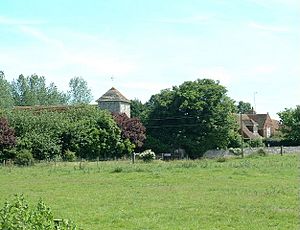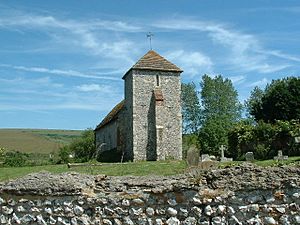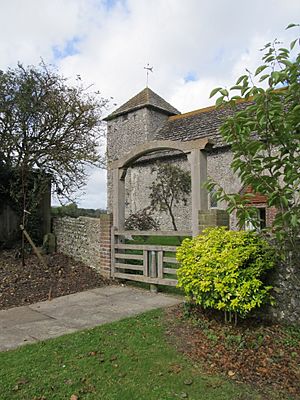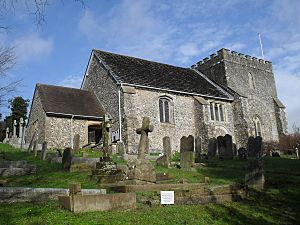St Botolph's Church, Botolphs facts for kids
Quick facts for kids St Botolph's Church |
|
|---|---|
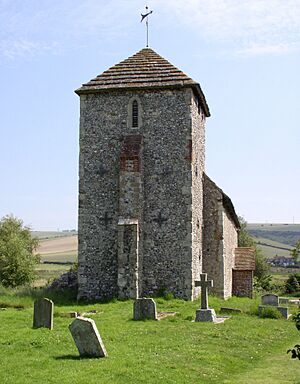
St Botolph's Church from the west
|
|
| 50°52′14″N 0°18′18″W / 50.8704689°N 0.3050819°W | |
| Location | Annington Rd, Botolphs, West Sussex, BN44 3WB |
| Country | England |
| Denomination | Church of England |
| Website | www.3bsparish.co.uk |
| History | |
| Former name(s) | Church of St Peter de Vetere Ponte |
| Status | Parish church |
| Founded | Late 11th century |
| Dedication | St Botolph |
| Architecture | |
| Functional status | Active |
| Heritage designation | Grade I |
| Designated | 15 March 1955 |
| Style | Saxon/Norman |
| Groundbreaking | Late 11th century |
| Administration | |
| Parish | Beeding and Bramber with Botolphs |
| Deanery | Rural Deanery of Storrington |
| Archdeaconry | Horsham |
| Diocese | Chichester |
| Province | Canterbury |
St Botolph's Church in Botolphs, West Sussex, England, is a very old church. It's a "Grade I listed building," which means it's super important and protected. It sits in the beautiful valley of the River Adur. Today, it's part of a larger group of churches called the Church of England parish of Beeding and Bramber with Botolphs.
Long ago, this church was also known as St Peter de Vetere Ponte. This name meant "St Peter of the Old Bridge." That old bridge over the River Adur is now gone. The church serves the small area of Botolphs, which used to be a busier village. Inside, you can still see pieces of old wall paintings from the Middle Ages. The church also has a special wooden pulpit from the 1600s.
Contents
History of St Botolph's Church
The area around Botolphs became a parish during the Saxon era. This was a time long before the Norman Conquest. The land was divided into long, narrow sections near the River Adur. This river flows into the English Channel at Shoreham. Botolphs, like its neighbors Beeding and Bramber, stretched for about 3.2 kilometers (2 miles) from west to east.
In 1086, a big survey called the Domesday Book mentioned a place called Hanyngedune. This area was the same as the later parish of Botolphs. King Eadwig first gave away this land in 956.
How Botolphs Village Grew
The land in Botolphs had two higher areas that rose above a flat, flood-prone plain. Because of this, two small settlements grew up separately. Some flint cottages were built around the Annington manor house and its farm. A few other homes gathered around the church. The area near the church was first called Old Bridge. Later, it became known as Botolphs. Old Roman building pieces found nearby suggest the church was built close to a very old bridge over the river. This bridge is now gone.
Changes in the Church's Name
The Domesday survey mentioned a church at Annington. Experts believe St Botolph's Church is the same one. Its design shows it was built by the Saxons. This means only one church served the area, not two as some once thought. The church was likely first named after St Botolph.
Around the time of the Norman Conquest, the church was officially renamed St Peter de Vetere Ponte. But by 1254, the name St Botolph reappeared. For a while, both names were used. Locals kept using the old name. By the 1400s, the name St Peter was no longer used. Some also think it might have been dedicated to St Mary at one point. The fact that there was another St Peter's Church nearby in Beeding might be why the name went back to St Botolph.
The River Adur used to be deep enough for boats all the way to Bramber. But around 1350, the sea started to pull back, and the river filled with mud. The bridge at Botolphs became useless, and the village's population got smaller. The river crossing had been used for about 1,000 years. When it was lost, the village could no longer grow. In 1526, Botolphs became part of Bramber parish.
Over the centuries, the church changed size as the population changed. At first, it was a simple building with a nave (main area) and a chancel (area near the altar). In the 1200s, a tower was added. Around 1250, an aisle (a side section) was added to the north side. This aisle had three arches connecting it to the nave. The chancel was changed, and new windows were put in during the 1300s. In 1536, the tower got three bells.
The north aisle, which might have held a special shrine, became old and broken by the late 1700s. This was because the population kept falling. By 1830, the aisle was taken down. This left the three blank arches on the north wall of the church.
A timber-framed house for the vicar (church leader) existed by 1615. It might even be from the 1300s. This building still stands next to the church today, though it has been changed over time. It was also made a "Grade II listed building" in 1980, meaning it's also important.
Church Design and Features
St Botolph's Church is in a very quiet place next to the River Adur. Even though there used to be a cement factory and a railway line nearby, they are no longer operating. In 1932, a historian noted that a new road along the river helped more people visit this church and its quiet neighbor, Coombes Church. These are called "little lost Downland churches."
In the 1800s, some people didn't think much of the church. One writer called it "small and uninteresting." But others have praised its "simple and mellow" feel, and its "clean lines [and] perfect setting."
Inside the Church
The main parts of the church, the nave and chancel, are Saxon. We don't know their exact age. The nave is long and narrow, about 16.9 meters (55 feet 6 inches) long and 5.3 meters (17 feet 6 inches) wide inside. On the south wall, at the west end, there's an original round-topped Saxon window. The south doorway was added in the 1600s, with a newer porch. The chancel is about 4.9 meters (16 feet) long and 3 meters (10 feet) wide inside. The arch leading to the chancel is also from the late Saxon period.
The north aisle, added around 1250, had three arches. By the early 1800s, these arches were filled in, and the aisle was taken down. This shows how the population of Botolphs had shrunk. The remains of these pointed arches are still a clear feature on the north wall.
Old Wall Paintings and Pulpit
In 1897, people found traces of old wall paintings. In 1932, they thought these paintings showed a "Doom" scene, which often showed the Last Judgment. They might have included pictures of St John, the Virgin Mary, and a bishop. Today, only a few unclear patches can be seen.
The wooden pulpit almost certainly dates from 1630. It used to be painted blue. It has interesting carved patterns all over it.
One of the three bells from 1536 has an inscription that remembers the old dedication to St Peter. It says "Sancte Petre ora pro nobis," which means "Saint Peter, pray for us."
A modern Tapsel gate was added in 2003. This special gate connects the churchyard to a nearby burial ground. This burial ground is used by the local councils of Bramber, Upper Beeding, and Steyning. The church's Rector (leader) is part of the group that manages this burial ground. An annual service for the burial ground is held in the church. The gate was paid for by the councils to make it easier for visitors to the burial ground to use the church. The Bishop of Horsham officially opened and dedicated it in early 2004.
St Botolph's Church Today
The church was made a "Grade I listed building" on March 15, 1955. This means it is of "exceptional interest" and is very important to the country's history. As of February 2001, it was one of 38 Grade I listed buildings in the Horsham area.
The right to choose the church's clergy (called the advowson) has belonged to the Bishop of Chichester since 1953. This right is shared with St Nicholas' Church at Bramber, which has been connected to St Botolph's since 1526. It's also connected to St Peter's Church in Beeding since 1987. These three churches now form one church parish, with one shared church council.
Long ago, the right to choose clergy belonged to Sele Priory in Beeding. This priory was linked to a church in France. Most of the priory's lands, including this right, were given to Magdalen College at the University of Oxford in the late 1400s. Magdalen College chose the rector until 1953, when they gave this right to the Bishop of Chichester.
Today, one Sunday service is held at St Botolph's Church each month, on the evening of the first Sunday. Other services are held at the other two churches in the parish, in Bramber and Upper Beeding. The combined parish serves about 5,000 people in these three villages and the surrounding countryside. It was officially created in 1987. Records of births, marriages, and deaths in the parish have been kept since 1601.
Images for kids
See also
- Grade I listed buildings in West Sussex
- List of places of worship in Horsham (district)
- Anglo-Saxon architecture


